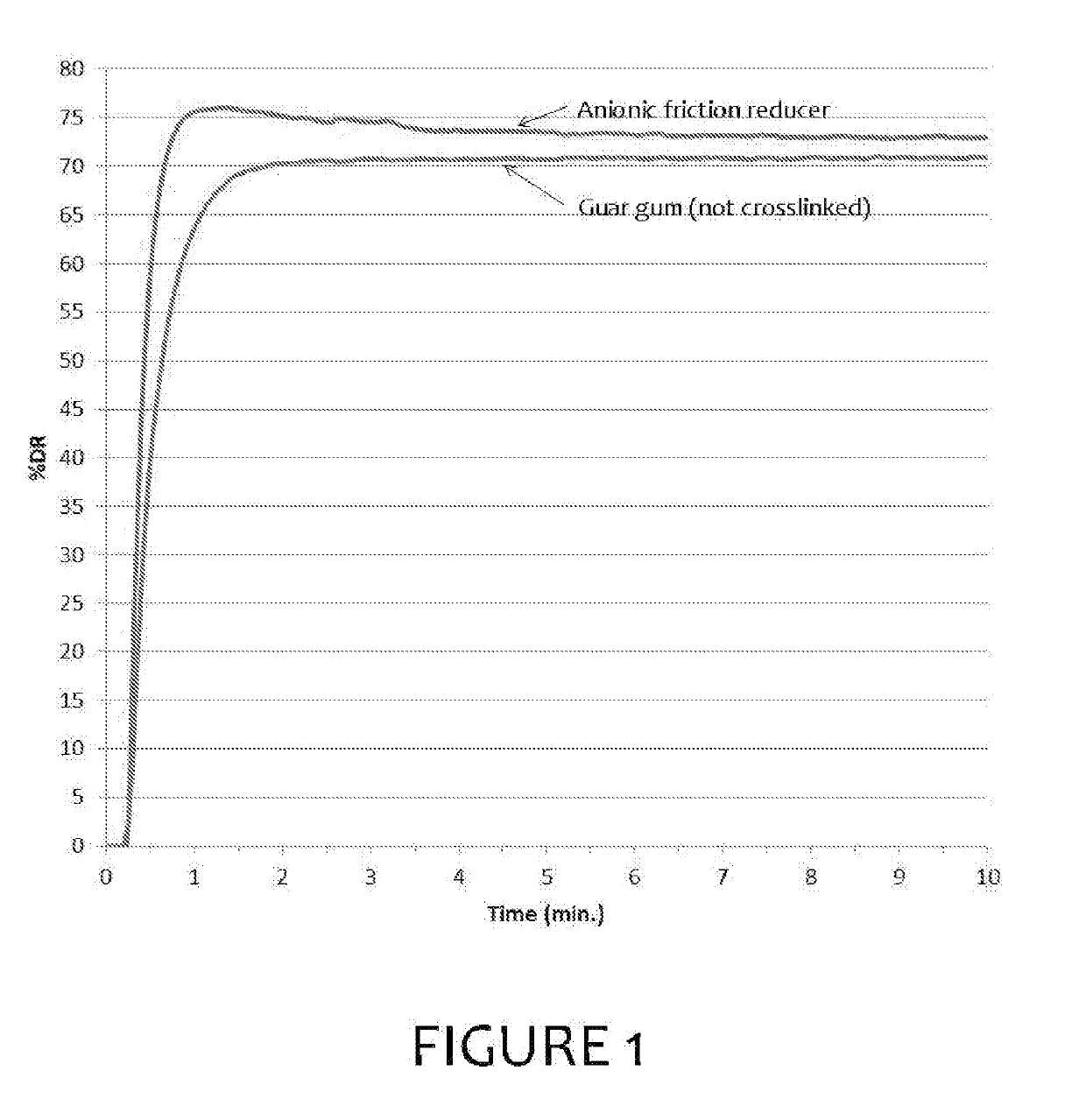Proppant Transport With Low Polymer Concentration Slurry
a technology of polymer concentration and slurry, which is applied in the direction of chemistry apparatus and processes, wellbore/well accessories, coatings, etc., can solve the problems of increasing the post, affecting the pump rate, and extending the post, so as to avoid the high pump rate, avoid the effect of high concentration and high viscosity
- Summary
- Abstract
- Description
- Claims
- Application Information
AI Technical Summary
Benefits of technology
Problems solved by technology
Method used
Image
Examples
example 1
tory Effects
[0063]To measure proppant suspension properties of a polymer (both before and after a shear history) in a dynamic test the following procedure was developed:[0064](a) Hydrate the polymer (to be evaluated) for 5 minutes at 1500 RPM.[0065](b) Add 120 gm of 20 / 40 coated or uncoated sand (2 pounds per gallon) and mix for 60 seconds at 1500 RPM. Note that the 120 grams would equate to 2 lb / gal if the test sample size is 500 ml.[0066](c) Lower RPM until sand accumulates on the bottom of the blender jar.[0067](d) Record the lowest RPM reading that does not cause sand accumulation.
[0068]To establish the shear sensitivity of the test sample repeat the above sequence adding a high shear step (3 minutes @ 4500 RPM) between steps (a) and (b).
[0069]Using the above procedure (both with and without including a shear history) with uncoated sand yielded the data in Table 1. The reported minimum rotations per minute (RPM) reflects the degree of dynamic movement necessary to keep the solid...
example 2
tory and Delayed Crosslinking
[0071]Using the same low polymer concentration and uncoated sand as example 1 but with a delayed onset of crosslinking had a substantial impact against degradation of the crosslinked polymer. In the following test, the uncrosslinked polymer used to create the low concentration, crosslinked, fluid of example 2 was subjected to the full shear history (3 minutes at 4500 RPM) that other samples experienced, but the onset of crosslink was delayed so that the crosslinked polymer was subjected to only 30 seconds of high shear. The system had a viscosity of 15-20 cps, we see this result in Table 2. The reported minimum rotations per minute (RPM) reflects the degree of dynamic movement necessary to keep the solids in suspension. The proppant is 20 / 40 uncoated sand.
TABLE 2SampleFRShear HistoryMin RPM2.1Guar (7ppt) +3 min at 4500 RPM after8001.25 pptcrosslinkingBBXL*2.2Guar (7ppt) +3 mins shear at 4500 rpm to4941.25 pptbase polymer + 30 s at 4500 rpmBBXL*after cros...
example 3
Anionic FR with Coated Proppant
[0075]Example 2 established that a delayed crosslinked approach (to a 7 ppt polymer loading) could result in substantial suspension of uncoated proppant. Example 3 investigated the compatibility of the crosslinked fluid formulation to a hydrophobically-coated proppant. The first test checked the compatibility of the guar polymer to the coating technology. Tests were performed on the base guar polymer compared to the high molecular weight, anionic, A-FRE-4. All tests were performed in tap water and using 20 / 40 FloPRO-coated proppant sand. All tests were also subjected to a shear history of 3 minutes at 4500 RPM as representative of a shear history similar to the trip down tubular goods to the fracture.
[0076]All the tests that incorporated the guar gave a poorer static suspension result as compared to the results obtained with the additional use of the A-FRE-4 anionic friction reducer / suspension aid. This includes the Guar 4045 in the same suspension pac...
PUM
| Property | Measurement | Unit |
|---|---|---|
| viscosities | aaaaa | aaaaa |
| velocity | aaaaa | aaaaa |
| distance | aaaaa | aaaaa |
Abstract
Description
Claims
Application Information
 Login to View More
Login to View More - R&D
- Intellectual Property
- Life Sciences
- Materials
- Tech Scout
- Unparalleled Data Quality
- Higher Quality Content
- 60% Fewer Hallucinations
Browse by: Latest US Patents, China's latest patents, Technical Efficacy Thesaurus, Application Domain, Technology Topic, Popular Technical Reports.
© 2025 PatSnap. All rights reserved.Legal|Privacy policy|Modern Slavery Act Transparency Statement|Sitemap|About US| Contact US: help@patsnap.com

